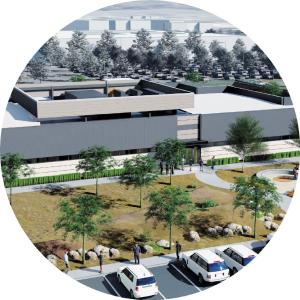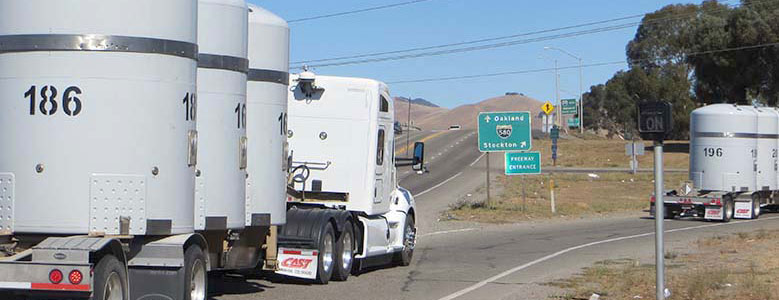Conducting safe, secure, and environmentally sound operations and modernizing the Laboratory's infrastructure to meet evolving mission needs
Committed to the highest level of operational performance, LLNL implements best practices in environment, safety, and health (ES&H), and security. Management systems support continuous improvement in work practices. Prudent risk management coupled with active measures to prevent accidents ensures the safety of employees and the public. Investments are targeted to modernize the Laboratory's infrastructure.
Responding to the Pandemic
The Laboratory responded quickly and effectively to the COVID-19 pandemic, enabling mission work to continue during these challenging times. At the end of January, when the COVID-19 threat was emerging, LLNL stood up its Pandemic Response Team and began moving to a safe standby operational posture on March 16th. Only the personnel needed to monitor Laboratory security, health of facilities, critical programmatic equipment, and to fulfill regulatory or other ongoing requirements had a routine presence onsite. Employee leave and work reporting options to staff and capabilities for wide-scale telecommuting were quickly established. Protocols and practices were developed and implemented, ensuring onsite workers would remain healthy.
On March 24th, Livermore received NNSA concurrence to resume additional onsite work. The restarted activities initially focused on core national security missions and progressed with gradual, deliberate resumptions until LLNL reached a state of Reduced Mission-Critical Operations on March 31st. By mid-May, a Mission-Critical Operations status was achieved. The Laboratory continued to resume and augment activities consistent with programmatic priorities and local conditions. Limited Operations was reached in early June and since early July the Laboratory has been operating effectively in Normal Operations with Maximum Telework status, with the daily onsite population reaching around 2,700 (roughly one-third full staff). Effective controls have minimized COVID-19 cases among the workforce and limited onsite transmission. LLNL has been able to continue working, with minimal impact to commitments and milestones.
Safe and Effective Operations
The health and safety of LLNL personnel has been paramount in the management decisions about the pace of increasing onsite activity. Health Services developed and implemented new protocols needed to ensure proper case management and contact tracing, and created a database to manage critical case information. In concert, LLNL’s biosafety team stayed abreast of the evolving guidance from health agencies—providing training courses, FAQs, risk assessments, and recommendations for face coverings and disinfection materials. Respirator Services worked to fit test and issue new models of respirators to workers. To address virus-related risks, new work controls were established that included administrative controls to limit population density, physical modifications in areas requiring long-term proximity, and work guidelines on personal protective equipment and social distancing requirements.
Within a week after moving to a safe standby operational posture, an extraordinary effort by LLNL information technology (IT) teams provided thousands of employees the ability to telecommute and work remotely. Researchers were able to maintain productivity, and major programmatic delays were mitigated. In spite of the pandemic, the Laboratory was able to sustain operations effectively and efficiently and meet mission commitments with high-quality deliverables. LLNL worked closely with NNSA’s Livermore Field Office to ensure that resources were allocated to maximum benefit in meeting FY 2020 program objectives. The necessary work adjustments and newly added IT capabilities have led to a substantial advancement in the efficiency of operations, safety, security, and environmental management and state-of-the-art business practices and processes. The Laboratory now operates with a new robust, secure virtual private network (VPN) for telecommuting—greatly enhancing work environment flexibility for employees.
Investing and Reinvesting in Infrastructure
In 2019, LLNL established an institutional Project Management (PM) Office, which provides modern PM processes and procedures to ensure on-cost, on-schedule project execution. In FY 2020, the $34-million Expand Electrical Distribution System Project was completed ahead of schedule, nearly $1 million under budget, and with no reportable injuries. New 15-kilovolt power cables were installed to eliminate single-point failures to current facilities and support planned development. The project involved excavating a trench more than 2 miles long and removing more than 20,000 cubic yards of soil. Other large scope projects, described in New Facilities and Modernized Infrastructure, are tracking to cost and schedule objectives. After a temporary halt in March, all mission critical construction activities and other essential programmatic work were restarted safely.
The Laboratory continuously upgrades facilities and equipment to help carry out LLNL’s mission safely and effectively. For example, an LLNL construction team completed a five-year major upgrade for the Laboratory’s wastewater monitoring and diversion system, known as the Sewer Monitoring Complex (SMC). The SMC is critical infrastructure and provides monitoring capability for LLNL to assure compliance with permitted sanitary sewer discharge limits as well as the capability to divert contaminated effluent in an emergency.
Radioactive Waste Removal from LLNL
In September 2020, drums of meticulously characterized and packaged highly radioactive transuranic (TRU) waste began to be shipped to the DOE Waste Isolation Pilot Plant (WIPP) at Carlsbad, New Mexico. Removal from LLNL of accumulated TRU waste, generated from research and development activities, has been a key NNSA goal for several years. WIPP Central Characterization Program personnel established three waste characterization capabilities in Livermore’s Radioactive and Hazardous Waste Management facilities. In 2019, LLNL was certified that its processes met stringent WIPP requirements. TRU waste characterization concluded in March 2020. A total of 624 drums and 13 standard waste boxes had been sent when the final shipment departed in October.








